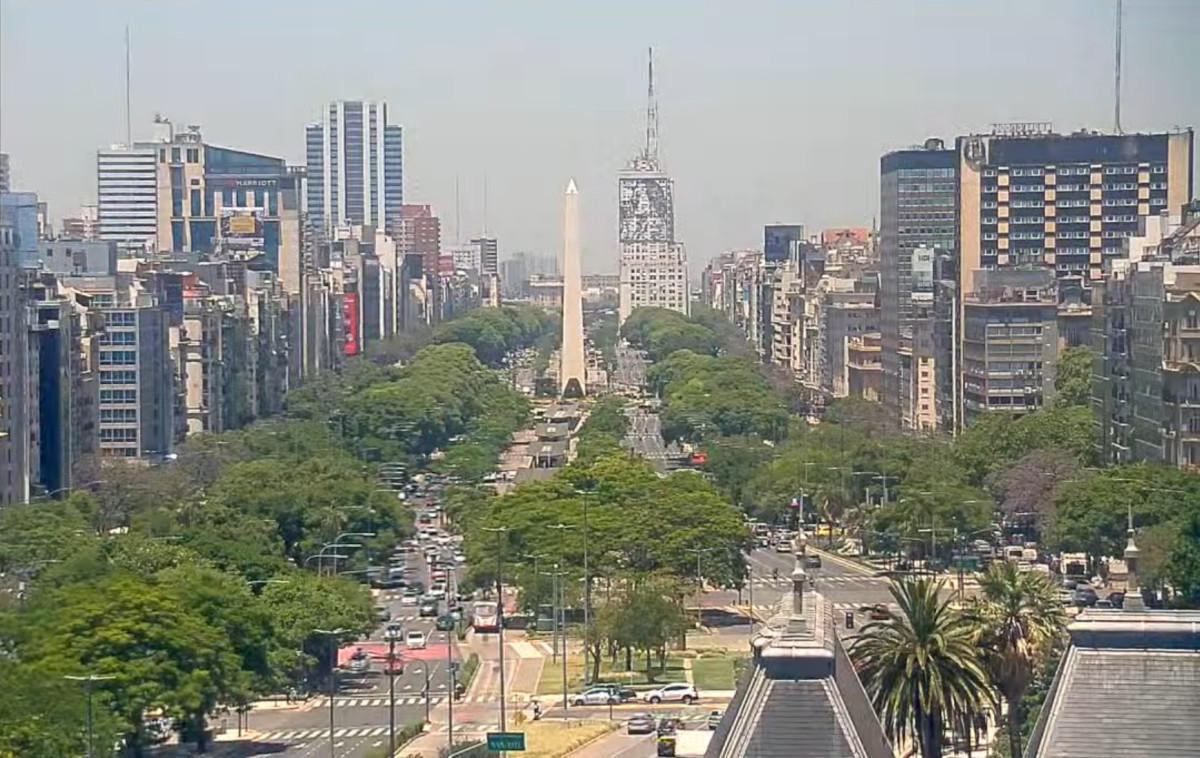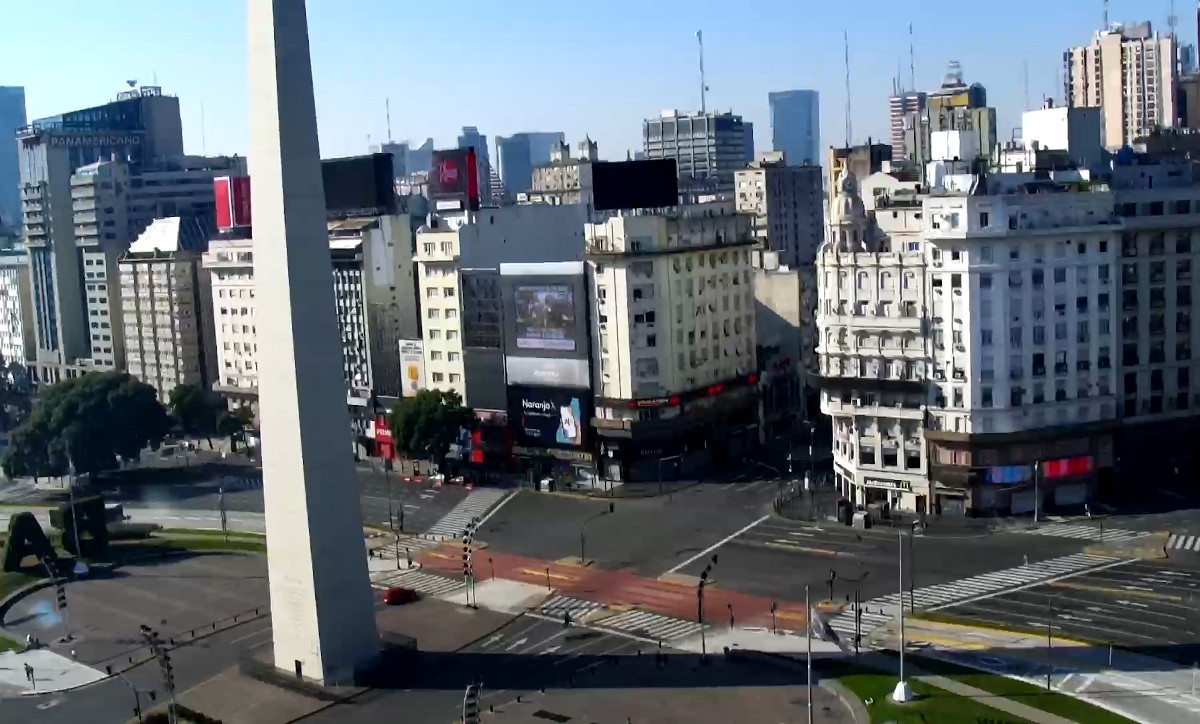Live Webcams in Buenos Aires
Live webcams in Buenos Aires broadcast real-time views of the city’s streets, squares, historic center, panoramas from restaurants and hotels, the airport, parks, embankments, and landmarks of the capital and largest city of Argentina. Live webcams show panoramic views of the city, its surrounding nature, and the weather conditions in Buenos Aires right now. Some webcams broadcast images with sound. Popular online webcams are listed at the top of the broadcasting list. A map of webcams shows the exact location of each live webcams in Buenos Aires.
Brief information about Buenos Aires
Buenos Aires (Spanish: Buenos Aires) is the capital and largest city of Argentina, the political, economic, and cultural center of the country, as well as one of the largest cities in South America. It covers an area of 202 km² and is home to over 3 million people. By population, Buenos Aires ranks 7th among the largest cities in South America after São Paulo (Brazil), Lima (Peru), Bogotá (Colombia), Rio de Janeiro (Brazil), Santiago (Chile), and Brasília (Brazil).
Buenos Aires is located in the estuary bay of La Plata on the east coast of Argentina, formed by the confluence of the Uruguay and Paraná rivers, 275 km from the Atlantic Ocean. 220 km from Buenos Aires, on the opposite bank of the estuary bay, lies the capital of Uruguay, Montevideo.
Buenos Aires is the largest seaport in Argentina and one of the largest maritime ports in South America. The city is home to numerous engineering, light, and printing industries.
Buenos Aires is one of the main tourist centers of Argentina and one of the most visited cities in South America. Every year, the capital of Argentina welcomes around 10 million tourists from all over the world.
Climate in Buenos Aires
The climate in Buenos Aires is humid subtropical with hot and humid summers and mild winters. The climate is greatly influenced by the Atlantic Ocean, which is located 270 km from the capital of Argentina. It moderates the climate and brings a lot of moisture to the city. The average air temperature in January, the summer month, is around +24°C, while in July, the winter month, it’s around +10°C.
Buenos Aires receives a significant amount of precipitation throughout the year, approximately 987 mm annually. The highest precipitation levels occur during the winter months, but heavy rains are also common in the summer. Snowfall is occasionally observed in the outskirts of Buenos Aires during winter, but snow in the city itself is extremely rare.
Summer in Buenos Aires lasts from December to February and is characterized by very hot days and warm nights. During the summer, periods of intense heat are often followed by heavy rain showers, which lead to a drop in temperature and an increase in humidity.
Winters in Buenos Aires are rainy and overcast with relatively mild days and cold nights. Winter temperatures rarely drop below 0°C, with the average air temperature in July being around +12°C. Dense fog is characteristic of Buenos Aires winters, sometimes lasting for several consecutive days.
The best time to visit Buenos Aires is during spring and autumn when precipitation is minimal, and the temperature remains comfortable.
Attractions of Buenos Aires
The sprawling city of Buenos Aires serves as the main tourist hub of Argentina and is one of the most popular tourist destinations in all of South America. Buenos Aires boasts numerous attractions that draw in large numbers of tourists from around the world. Among the most well-known and visited attractions of Buenos Aires are:
– The Pink House (Spanish: La Casa Rosada), also known as the Presidential Palace, is the official residence of the President of Argentina, located on the eastern side of the historic Plaza de Mayo in the heart of Buenos Aires. La Casa Rosada serves as the workplace of the President of Argentina, and the building houses a museum of government, where visitors can learn about Argentina’s presidents and their activities. The Pink House is considered one of the most visited and photographed landmarks of Buenos Aires and was declared a National Historic Monument in 1942.
– The Colon Theater (Spanish: Teatro Colon) is the main opera house of Argentina, named after the Spanish explorer and discoverer of the New World (Americas), Christopher Columbus. It is located on Avenida 9 de Julio near Plaza Lavalle in the city center. The Colon Theater is considered one of the best opera houses in the world. It houses an opera company, symphony, ballet, and orchestra, and also features a library and museum on its premises.
– Avenida 9 de Julio (July 9th Avenue) is the widest avenue in the world, stretching 120 meters across. The avenue traverses the central part of the city for over 2.6 kilometers. It is named after the signing of the Declaration of Independence of Argentina on July 9, 1816. Along Avenida 9 de Julio, visitors can find such famous Buenos Aires landmarks as the Colon Theater, Republic Square with the Obelisk, and Constitution Square.
– The Obelisk in Buenos Aires (Spanish: Obelisco de Buenos Aires) is a monument commemorating the 400th anniversary of the founding of Buenos Aires. It is an obelisk standing 67 meters tall, located in Republic Square at the intersection of Avenida 9 de Julio and Avenida Corrientes. The Obelisk is a symbol of Buenos Aires and one of the main venues for cultural and mass events in the city.
– The National Congress Palace of Argentina (Spanish: Palacio Del Congreso De La Nacion Argentina) is the seat of the National Congress of Argentina, the legislative body of the country. The palace was built in 1906 in the neoclassical style and is located opposite Congress Square in the center of Buenos Aires, 2 km from the Presidential Palace.
– The Barolo Palace (Spanish: Palacio Barolo) is a historic building constructed in 1923 in the Art Nouveau style and designated a National Historic Monument. It is located on Avenida de Mayo in the Monserrat district, in the historic center of Buenos Aires. The building stands 100 meters tall and was once the tallest building in all of South America.
– Plaza de Mayo (Spanish: Plaza De Mayo) is the main square of Buenos Aires. It was established in 1580 and served as the starting point for the construction of the Argentine capital. On September 13, 1816, Argentina’s independence was proclaimed here, and on October 21, 1860, the Argentine Constitution was announced. Plaza de Mayo is home to the Buenos Aires City Hall, the Pink House Presidential Palace, and the Buenos Aires Metropolitan Cathedral.
Among other famous and popular attractions in Buenos Aires are: the Women’s Bridge, Recoleta Cemetery, Basilica of the Holy Sacrament, Metropolitan Cathedral (La Catedral Metropolitana), Latin American Art Museum, and others.

